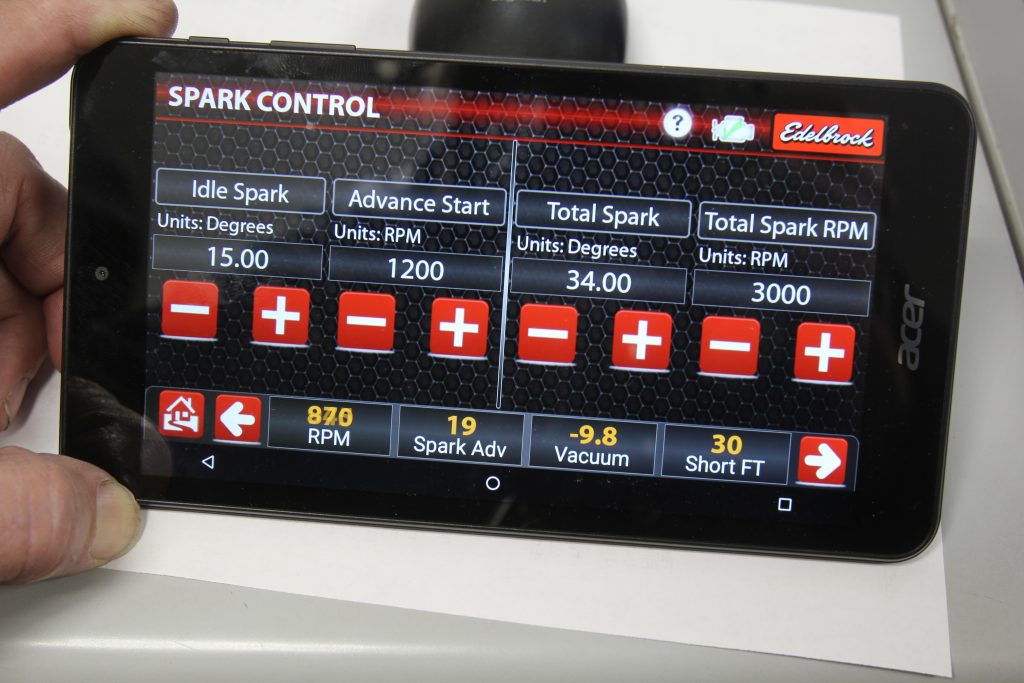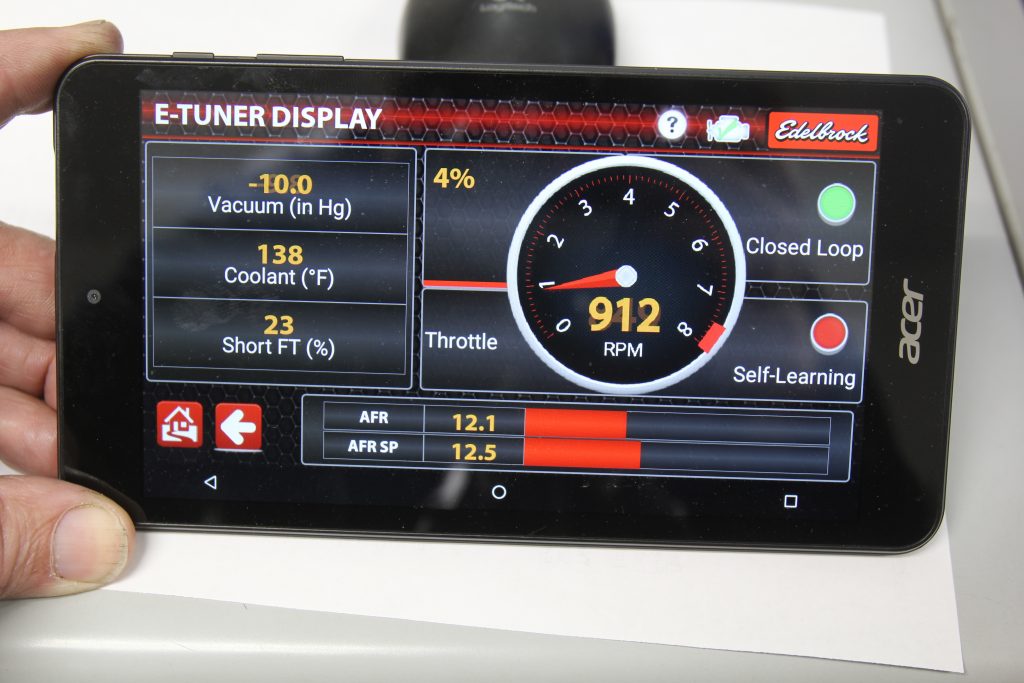I have a Ford 347 stroked small block with 10:1 compression and a “race cam.” The builder won’t give me cam specifics. I just installed the Edelbrock Pro Flo 4 EFI system. The ECU controls the timing. I’ve set the advance to 33 degrees to be safe. There’s also a vacuum advance setting that’s defaulted to 5 degrees…should I change that vacuum advance to a higher number? How will I know how much is too much? — K.R.
Jeff Smith: I have some experience with the Edelbrock ProFlo-4 and it is a great EFI system. There are three different base fuel maps, which are found in the configuration portion, based on cam timing. It’s unfortunate that the car builder can’t give you the specs since that’s the main way Edelbrock differentiates the different maps. One way you can help with this is by measuring the idle vacuum.
The Edelbrock dashboard display will list the idle vacuum in inches of mercury (“Hg). For a “race” cam, I would expect the idle vacuum to be less than 10” Hg, but there’s also a good chance that the vacuum will be higher than that – perhaps around 11-12 “Hg — or perhaps more. Milder camshaft timing creates higher engine idle vacuum.

This is important because if the cam is in fact a “race” cam and idle vacuum is 10” Hg or lower, then you will need some part-throttle ignition timing supplied by the vacuum advance setting. Since you have decent compression, this tends to reduce or soften the requirement for more timing. The engines that need a ton of vacuum advance generally have longer duration cams and lower compression.
The ProFlo-4 uses 5 degrees of vacuum advance as the default setting which is a good place to start. The engine will generally tell you what it wants for timing. One way to tell is to test on a flat portion of highway that extends for a few miles. Drive a portion of the highway and have a friend record the manifold vacuum level at a normal, steady state cruising speed. As an example, let’s put this number at 14” Hg. Now add a few more degrees of vacuum advance and run the highway test again at the same speed/rpm.
If the manifold vacuum increases, even slightly, then this indicates that the engine is making more power, which means you are backing off the throttle and raising the vacuum. Another indicator would be the throttle position as reported by the TPS – throttle position sensor. Even having the same manifold vacuum or throttle position can still be viewed as a positive step. If you add more and the engine begins to surge at part throttle, that’s a clear indication that you have too much vacuum advance.
What’s happening when the engine surges is that the ignition is starting too soon and the engine is creating cylinder pressure before the pistons arrive at Top Dead Center (TDC), so the engine is fighting itself. Just back off about 3-4 degrees and try again. The steady state cruise with the highest manifold vacuum is where you want to be.
Unfortunately, the ProFlo-4 only offers a maximum of 10 degrees of vacuum advance so the amount of timing you can add here is somewhat limited, but it will offer advantages. We recently tested the ProFlo-4 on a 540 cubic-inch big-block Chevy and performed a version of this highway cruise test. We placed the engine at around 2,600 rpm with 70 ft.-lbs. of load and then adjusted both fuel and spark. This engine wanted the maximum amount of vacuum advance we could add, which was only 10 degrees.

To help this situation, we also quickened the mechanical advance rate by placing the end point for advance at a lower rpm. For example, instead of ending advance at 3,000 rpm, we moved it to 2,600. This adds a little more advance at lower engine speeds. We watched as the torque improved every time we added more timing. So at least in that specific engine’s case, it wanted more timing. Not all engines will respond the same way.
That Rat motor also preferred to run rich. We saw an increase of 15 ft.-lbs. by running at a much richer 12.5:1 AFR at part throttle. Unfortunately, this would hurt fuel mileage, so we found that leaning the AFR to around 13.1:1 was acceptable. Anything leaner than this, however, really hurt the torque on from this engine.
So you can see that this is something of a balancing act.
Since you don’t have a dyno, the AFR numbers will have to be more of a long-term experiment. Try starting around 13.5:1 as your highway cruise AFR and see how the engine responds with regard to fuel mileage. The beauty of EFI is that you can make instant changes and then evaluate the results.
Have fun!

I just learned from Edelbrock that their latest software update 4.0.1:7 with the V65 firmware will now allow 15 degrees of vacuum advance instead of the 10 degrees mentioned in the story. This software is easily updated on teh Edelbrock tablet and Edelbrock tells me it is available through teh Google Play store.
Hey Jeff,
I have the same configuration 347. My issue is it runs very rich at idle. If you could advise it would be appreciated. Thank you
How do I get better mileage with system, I have what they call a Rv cam. I can’t find anyone in my area, who knows how to set up h to his system. I live in Wausau , Wisconsin.
How do I get a system like this bought and paid for it in February from summit. Still haven’t received it. No emails or eta on the system. Been almost 5 months
Hi Cody–Sorry to hear that you’re waiting on your system. Have you been in contact with Summit Racing’s customer service folks? Although OnAllCylinders isn’t an official customer service channel for Summit Racing, you can contact them here, or if you’ve got a Facebook account, you can have a customer service manager review your order by submitting your customer/order number over on Summit Racing’s Facebook page.
I want to use the pro- flo 4 part number 35690 the motor is a blue print 454 small block the cam is 638/622 lift and 251/259 duration hp is 560 and 7.50 vacuum at 950 rpm and I have a t56 6 speed with 370 rear gear and 30” tall tires, so my question is will the pro flo 4 work with 7.50” idle vacuum I will be idling at about 1100 rpm, thanks .
I wish I knew. I’m running a 350 with a mild cam and aluminum heads
In a 1957 Chevy Bel Air. I was getting 18to20 mpg with a quadrajet and with the pro flo 4 I’m getting 12 mpg. I’m thinking of going back to the quadrajet.
Does any one fave an idea to improve the mileage
I have a 388 sbc stroker.. hr camshaft 525/550 lift 236/242 dur@50… 10.5 cI..
AFR 195cc heads. With carb I was getting 10-12 inches of vacume at 750rpms, with proflow 4 I am getting 6.8 at 775 rpms, if I give a little rev, the engine sounds like it’s not on 8 cylinders, it’s very rough..
I don’t know how relevant this is but it pertains to the Proflo4xt. I recently had a TPS error code on my TCI tranny controller so I sent it in to to be serviced ok I got it it back but haven’t gotten the controller back due to stocking issues. Question one is: without the controller to put in a program to the TVI ECU the will not shift correct?? I also was adviced by the techs at edelbrock not to highjack tge TPS signsal with splices. So I got tge remote TPS mounted device hopefully that solves my issues. Thank you.
Also would it a good idea to get a adjustable TPS for tgat system??